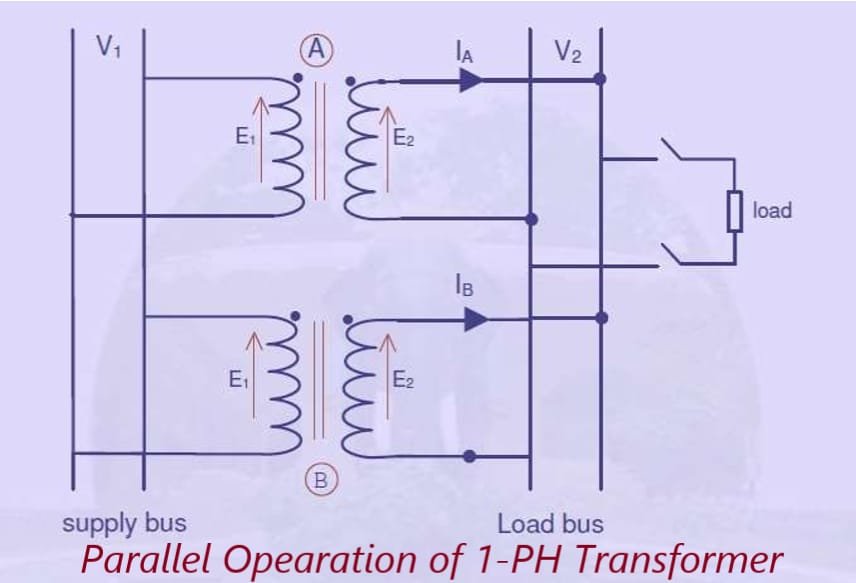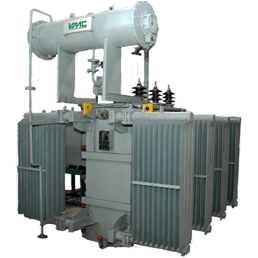Table of Contents
ToggleWhy Parallel Operation of Transformers required
By parallel operation we mean two or more transformers are connected to the same supply bus bars on the primary side and to a common bus bar/load on the secondary side.
Such requirement is frequently encountered in practice. The reasons that necessitate parallel operation are as follows.
Non-availability of a single large transformer to meet the total load requirement.
The power demand might have increased over a time necessitating augmentation of the capacity. More transformers connected in parallel will then be pressed into service.
To ensure improved reliability. Even if one of the transformers gets into a fault or is taken out for maintenance/repair the load can continued to be serviced.
To reduce the spare capacity. If many smaller size transformers are used one machine can be used as spare. If only one large machine is feeding the load, a spare of similar rating has to be available. The problem of spares becomes more acute with fewer machines in service at a location.
When transportation problems limit installation of large transformers at site, it may be easier to transport smaller ones to site and work them in parallel.
Parallel operation of Two Single phase Transformer

Fig. shows the physical arrangement of two single phase transformers working in parallel on the primary side. Transformer A and Transformer B are connected to input voltage bus bars. After ascertaining the polarities they are connected to output/load bus bars. Certain conditions have to be met before two or more transformers are connected in parallel and share a common load satisfactorily. They are,
The voltage ratio must be the same.
The per unit impedance of each machine on its own base must be the same.
The polarity must be the same, so that there is no circulating current between the transformers.
The phase sequence must be the same and no phase difference must exist between the voltages of the two transformers.
Same Voltage Ratio
Generally the turns ratio and voltage ratio are taken to be the same. If the ratio is large there can be considerable error in the voltages even if the turns ratios are the same.
When the primaries are connected to same bus bars, if the secondaries do not show the same voltage, paralleling them would result in a circulating current between the secondaries.
Reflected circulating current will be there on the primary side also. Thus even without connecting a load considerable current can be drawn by the transformers and they produce copper losses.
In two identical transformers with percentage impedance of 5 percent, a no-load voltage difference of one percent will result in a circulating current of 10 percent of full load current. This circulating current gets added to the load current when the load is connected resulting in unequal sharing of the load. In such cases the combined full load of the two transformers can never be met without one transformer getting overloaded.
Per unit impedance
Transformers of different ratings may be required to operate in parallel. If they have to share the total load in proportion to their ratings the larger machine has to draw more current. The voltage drop across each machine has to be the same by virtue of their connection at the input and the output ends.
Thus the larger machines have smaller impedance and smaller machines must have larger ohmic impedance. Thus the impedances must be in the inverse ratios of the ratings. As the voltage drops must be the same the per unit impedance of each transformer on its own base, must be equal.
In addition if active and reactive power are required to be shared in proportion to the ratings the impedance anglesalso must be the same. Thus we have the requirement that per unit resistance and per unit reactance of both the transformers must be the same for proper load sharing.
Polarity of connection
The polarity of connection in the case of single phase transformers can be either same or opposite. Inside the loop formed by the two secondaries the resulting voltage must be zero. If wrong polarity is chosen the two voltages get added and short circuit results.
In the case of polyphase banks it is possible to have permanent phase error between the phases with substantial circulating current. Such transformer banks must not be connected in parallel.
The turns ratios in such groups can be adjusted to give very close voltage ratios but phase errors cannot be compensated. Phase error of 0.6 degree gives rise to one percent difference in voltage. Hence poly phase transformers belonging to the same vector group alone must be taken for paralleling.
Transformers having −30◦ angle can be paralleled to that having +30◦ angle by reversing the phase sequence of both primary and secondary terminals of one of the transformers. This way one can overcome the problem of the phase angle error.
Phase sequence
The phase sequence of operation becomes relevant only in the case of poly phase systems. The poly phase banks belonging to same vector group can be connected in parallel. A transformer with +30◦ phase angle however can be paralleled with the one with −30◦ phase angle, the phase sequence is reversed for one of them both at primary and secondary terminals.
If the phase sequences are not the same then the two transformers cannot be connected in parallel even if they belong to same vector group. The phase sequence can be found out by the use of a phase sequence indicator.
Performance of two or more single phase transformers working in parallel can be computed using their equivalent circuit. In the case of poly phase banks also the approach is identical and the single phase equivalent circuit of the same can be used.


Pingback: Transformer Differential Protection and their diagram
Rattling great visual appeal on this internet site, I’d value it 10 10.